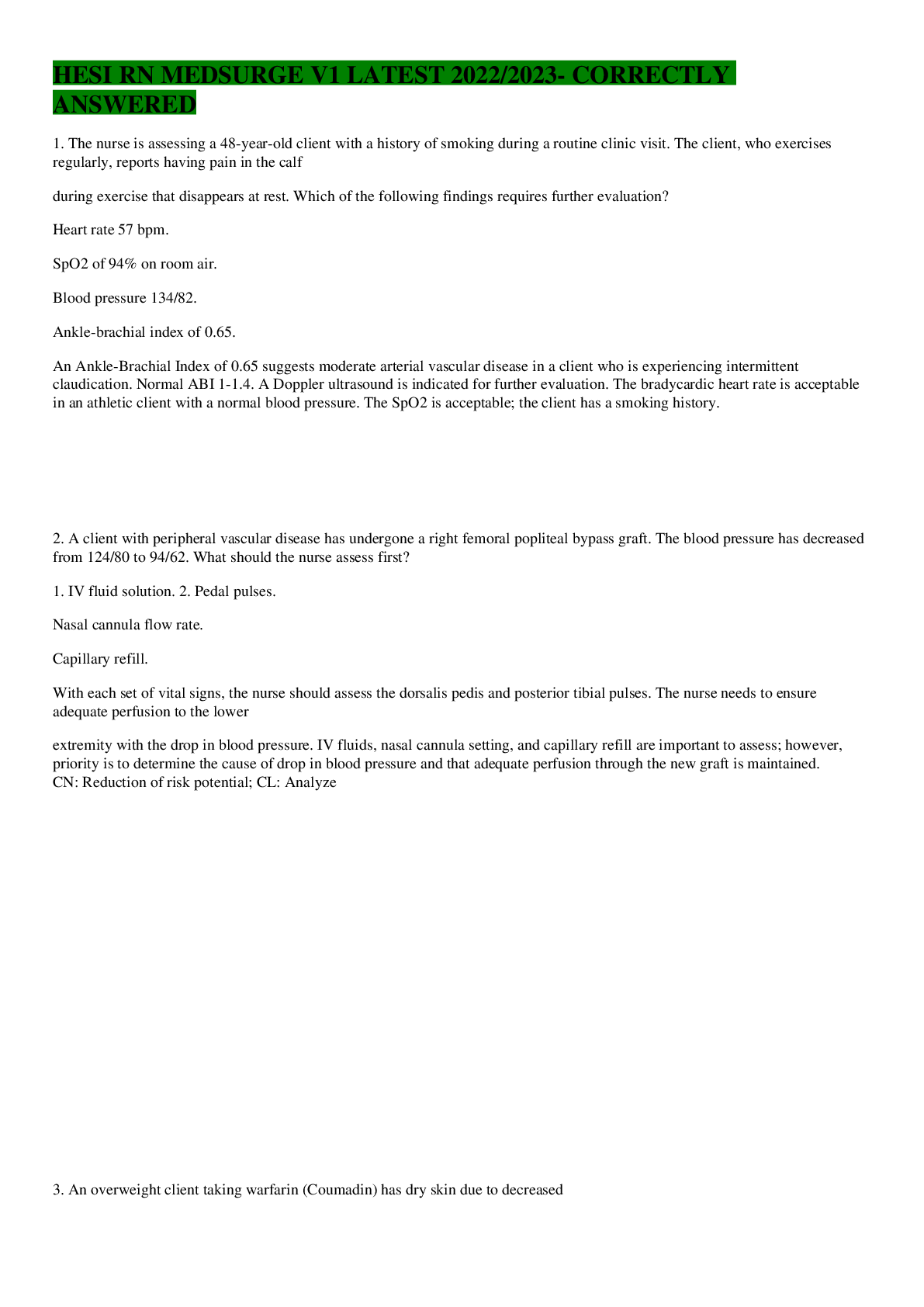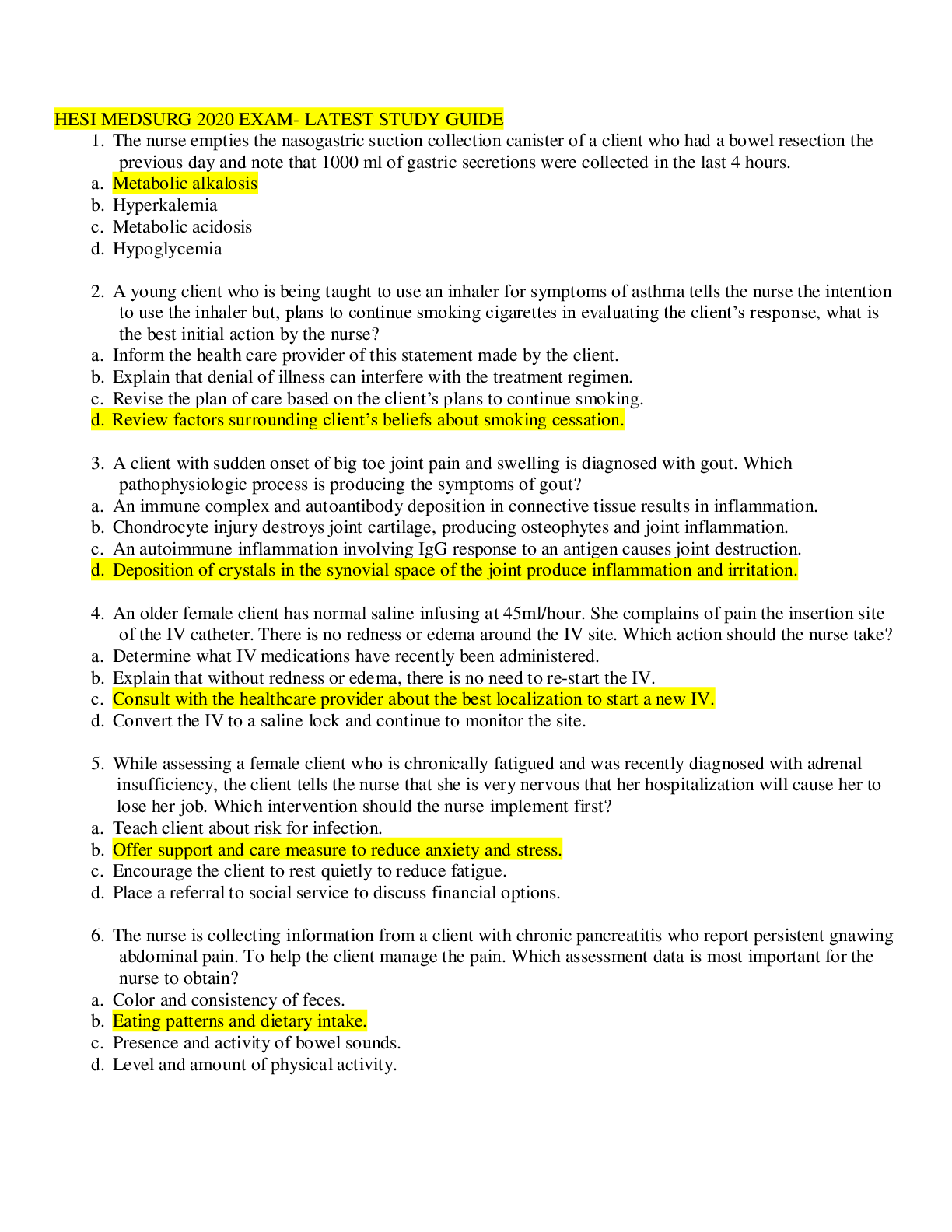Health Care > HESI MED SURG > HESI RN MEDSURGE V1 LATEST 2022/2023- CORRECTLY ANSWERED (All)
HESI RN MEDSURGE V1 LATEST 2022/2023- CORRECTLY ANSWERED
Document Content and Description Below
The nurse is assessing a 48-year-old client with a history of smoking during a routine clinic visit. The client, who exercises regularly, reports having pain in the calf during exercise that disappea... rs at rest. Which of the following findings requires further evaluation? 1. Heart rate 57 bpm. 2. SpO2 of 94% on room air. 3. Blood pressure 134/82. 4. Ankle-brachial index of 0.65. An Ankle-Brachial Index of 0.65 suggests moderate arterial vascular disease in a client who is experiencing intermittent claudication. Normal ABI 1-1.4. A Doppler ultrasound is indicated for further evaluation. The bradycardic heart rate is acceptable in an athletic client with a normal blood pressure. The SpO2 is acceptable; the client has a smoking history. 2. A client with peripheral vascular disease has undergone a right femoral popliteal bypass graft. The blood pressure has decreased from 124/80 to 94/62. What should the nurse assess first? 1. IV fluid solution. 2. Pedal pulses. 3. Nasal cannula flow rate. 4. Capillary refill. With each set of vital signs, the nurse should assess the dorsalis pedis and posterior tibial pulses. The nurse needs to ensure adequate perfusion to the lower extremity with the drop in blood pressure. IV fluids, nasal cannula setting, and capillary refill are important to assess; however, priority is to determine the cause of drop in blood pressure and that adequate perfusion through the new graft is maintained. CN: Reduction of risk potential; CL: Analyze 3. An overweight client taking warfarin (Coumadin) has dry skin due to decreased arterial blood flow. What should the nurse instruct the client to do? Select all that apply. 1. Apply lanolin or petroleum jelly to intact skin. 2. Follow a reduced-calorie, reduced-fat diet.- promote circulation by reducing weight. 3. Inspect the involved areas daily for new ulcerations. 4. Instruct the client to limit activities of daily living (ADLs). 5. Use an electric razor to shave. 1, 2, 3, 5. Maintaining skin integrity is important in preventing chronic ulcers and infections. The client should be taught to inspect the skin on a daily basis. The client should reduce weight to promote circulation; a diet lower in calories and fat is appropriate. Because the client is receiving Coumadin, the client is at risk for bleeding from cuts. To decrease the risk of cuts, the nurse should suggest that the client use an electric razor. The client with decreased arterial blood flow should be encouraged to participate in ADLs. In fact, the client should be encouraged to consult an exercise physiologist for an exercise program that enhances the aerobic capacity of the body. CN: Health promotion and maintenance; CL: Synthesize 4. The nurse is caring for a client with peripheral artery disease who has recently been prescribed clopidogrel (Plavix). The nurse understands that more teaching is necessary when the client states which of the following: 1. “I should not be surprised if I bruise easier or if my gums bleed a little when brushing my teeth.” 2. “It doesn't really matter if I take this medicine with or without food, whatever works best for my stomach.” 3. “I should stop taking Plavix if it makes me feel weak and dizzy.” 4. “The doctor prescribed this medicine to make my platelets less likely to stick together and help prevent clots from forming.” Weakness, dizziness, and headache are common adverse effects of Plavix and the client should report these to the physician if they are problematic; in order to decrease risk of clot formation, Plavix must be taken regularly and should not be stopped or taken intermittently. The main adverse effect of Plavix is bleeding, which often occurs as increased bruising or bleeding when brushing teeth. Plavix is well absorbed, and while food may help decrease potential gastrointestinal upset, Plavix may be taken with or without food. Plavix is an antiplatelet agent used to prevent clot formation in clients who have experienced or are at risk for myocardial infarction, ischemic stroke, peripheral artery disease, or acute coronary syndrome. CN: Pharmacological and parenteral therapies; CL: Evaluate 5. A client is receiving Cilostazol (Pletal) for peripheral arterial disease causing intermittent claudication. The nurse determines this medication is effective when the client reports which of the following? 1. “I am having fewer aches and pains.” 2. “I do not have headaches anymore.” 3. “I am able to walk further without leg pain.” 4. “My toes are turning grayish black in color.” Cilostazol is indicated for management of intermittent claudication. Symptoms usually improve within 2 to 4 weeks of therapy. Intermittent claudication prevents clients from walking for long periods of time. Cilostazol inhibits platelet aggregation induced by various stimuli and improving blood flow to the muscles and allowing the client to walk long distances without pain. Peripheral arterial disease causes pain mainly of the leg muscles. “Aches and pains” does not specify exactly where the pain is occurring. Headaches may occur as a side effect of this drug, and the client should report this information to the health care provider. Peripheral arterial disease causes decreased blood supply to the peripheral tissues and may cause gangrene of the toes; the drug is effective when the toes are warm to the touch and the color of the toes is similar to the color of the body. CN: Pharmacological and parenteral therapies; CL: Evaluate 6. The client admitted with peripheral vascular disease (PVD) asks the nurse why her legs hurt when she walks. The nurse bases a response on the knowledge that the main characteristic of PVD is: 1. Decreased blood flow. 2. Increased blood flow. 3. Slow blood flow. 4. Thrombus formation. 7. The nurse is planning care for a client who is diagnosed with peripheral vascular disease (PVD) and has a history of heart failure. The nurse should develop a plan of care that is based on the fact that the client may have a low tolerance for exercise related to: 1. Decreased blood flow. 2. Increased blood flow. 3. Decreased pain. 4. Increased blood viscosity. 8. When assessing the lower extremities of a client with peripheral vascular disease (PVD), the nurse notes bilateral ankle edema. The edema is related to: 1. Competent venous valves. 2. Decreased blood volume. 3. Increase in muscular activity. 4. Increased venous pressure. 9. The nurse is obtaining the pulse of a client who has had a femoral-popliteal bypass surgery 6 hours ago. (See below) Which assessment provides the most accurate information about the client's postoperative status? NA 10. The nurse is teaching a client about risk factors associated with atherosclerosis and how to reduce the risk. Which of the following is a risk factor that the client is not able to modify? 1. Diabetes. 2. Age. 3. Exercise level. 4. Dietary preferences. 11. The nurse is assessing the lower extremities of the client with peripheral vascular disease (PVD). During the assessment, the nurse should expect to find which of the following clinical manifestations of PVD? Select all that apply. 1. Hairy legs. 2. Mottled skin. 3. Pink skin. 4. Coolness. 5. Moist skin. 12. The nurse is unable to palpate the client's left pedal pulses. Which of the following actions should the nurse take next? 1. Auscultate the pulses with a stethoscope. 2. Call the physician. 3. Use a Doppler ultrasound device. 4. Inspect the lower left extremity. 13. Which of the following lipid abnormalities is a risk factor for the development of atherosclerosis and peripheral vascular disease? 1. Low concentration of triglycerides. 2. High levels of high-density lipid (HDL) cholesterol. 3. High levels of low-density lipid (LDL) cholesterol. 4. Low levels of LDL cholesterol. 14. When assessing an individual with peripheral vascular disease, which clinical manifestation would indicate complete arterial obstruction in the lower left leg? 1. Aching pain in the left calf. 2. Burning pain in the left calf. 3. Numbness and tingling in the left leg. 4. Coldness of the left foot and ankle. 15. A client with peripheral vascular disease returns to the surgical care unit after having femoral-popliteal bypass grafting. Indicate in which order the nurse should conduct assessment of this client. 1. Postoperative pain. 2. Peripheral pulses. 3. Urine output. 4. Incision site. 2,4,3,1 16. A client with heart failure has bilateral +4 edema of the right ankle that extends up to midcalf. The client is sitting in a chair with the legs in a dependent position. Which of the following goals is the priority? 1. Decrease venous congestion. 2. Maintain normal respirations. 3. Maintain body temperature. 4. Prevent injury to lower extremities. 17. The nurse is assessing an older Caucasian male who has a history of peripheral vascular disease. The nurse observes that the man's left great toe is black. The discoloration is probably a result of: 1. Atrophy. 2. Contraction. 3. Gangrene. 4. Rubor. CONTINUED............DOWNLOAD FOR BEST SCORES [Show More]
Last updated: 2 years ago
Preview 1 out of 38 pages

Buy this document to get the full access instantly
Instant Download Access after purchase
Buy NowInstant download
We Accept:

Reviews( 0 )
$14.50
Can't find what you want? Try our AI powered Search
Document information
Connected school, study & course
About the document
Uploaded On
Dec 03, 2022
Number of pages
38
Written in
Additional information
This document has been written for:
Uploaded
Dec 03, 2022
Downloads
0
Views
125



